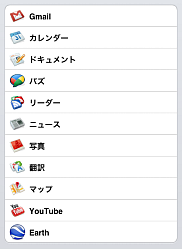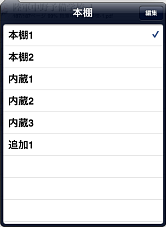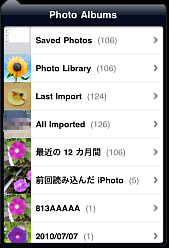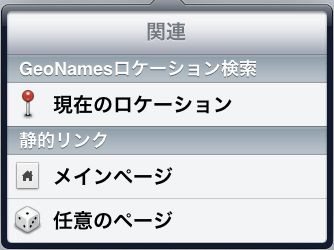☆Cocoa Touch UIKit勉強(4)
UITableView
UITableViewは、テーブル形式の画面表示や編集を制御するビューである。 UIKitが提供するテーブルビューは、小さな画面ゆえに縦1列に限っている。 多くの制御が出来るため、プロパティーやメソッドが非常に多い。
Table View Programming Guide for iOSも参照のこと。
テーブルビューは0以上の「セクション」からなる。各セクションはそれぞれ行を持っている。 セクションに分けることを「グループ化」という。
各セクションには上にヘッダを、下にフッタを付けることが出来る。
| 単一(plane)形式(例1) | 単一形式(例2) | 単一形式(例3) | グループ化=セクションがある形式 |
 |  |  |  |
UITableView
| メソッド名 | 動作 | ||||||||||||||
| -(id)initWithFrame:(CGRect)frame style:(UITableViewStyle)style | 形を指定してテーブルビューオブジェクトを初期化する | ||||||||||||||
| -(NSInteger)numberOfRowsInSection:(NSInteger)section | 指定セクションの行数を返す | ||||||||||||||
| -(NSInteger)numberOfSections | レシーバー内のセクション数を返す | ||||||||||||||
| -(NSIndexPath *)indexPathForCell:(UITableViewCell *)cell | 与えられたテーブルビューセルの行とセクションをインデックスパスで返す | ||||||||||||||
| -(NSIndexPath *)indexPathForRowAtPoint:(CGPoint)point | タッチポイントで与えられた行とセクションをインデックスパスで返す | ||||||||||||||
| -(NSIndexPath *)indexPathForSelectedRow | 選択された行の行とセクションをインデックスパスで返す | ||||||||||||||
| -(NSArray *)indexPathsForRowsInRect:(CGRect)rect | 与えられた長方形で囲まれる行の示すインデックスパスの配列を返す | ||||||||||||||
| -(NSArray *)indexPathsForVisibleRows | レシーバー内で見えている行のインデックスパスの配列を返す | ||||||||||||||
| -(void)reloadData | 行とセクションのデータをリロードする | ||||||||||||||
| -(void)reloadRowsAtIndexPaths:(NSArray *)indexPaths withRowAnimation:(UITableViewRowAnimation)animation | アニメーション効果を使って指定行をリロードする | ||||||||||||||
| -(void)reloadSectionIndexTitles | テーブルビュー右のインデックスバー内のアイテムをリロードする | ||||||||||||||
| -(void)reloadSections:(NSIndexSet *)sections withRowAnimation:(UITableViewRowAnimation)animation | アニメーション効果を使って指定セクションをリロードする | ||||||||||||||
| -(void)scrollToNearestSelectedRowAtScrollPosition:(UITableViewScrollPosition)scrollPosition animated:(BOOL)animated | 選ばれた行が指定された位置の最も近くにあるように、テーブルビューをスクロールする
UITableViewScrollPosition(enum値)
| ||||||||||||||
| -(void)scrollToRowAtIndexPath:(NSIndexPath *)indexPath atScrollPosition:(UITableViewScrollPosition)scrollPosition animated:(BOOL)animated | インデックスパスによって確認される行がスクリーンで特定の場所にくるまでレシーバーをスクロールする | ||||||||||||||
| -(void)selectRowAtIndexPath:(NSIndexPath *)indexPath animated:(BOOL)animated scrollPosition:(UITableViewScrollPosition)scrollPosition | インデックスパスで指定される行を選択する(スクロール付き) | ||||||||||||||
| -(void)deselectRowAtIndexPath:(NSIndexPath *)indexPath animated:(BOOL)animated | インデックスパスで指定される行を非選択にする | ||||||||||||||
| -(NSArray *)visibleCells | レシーバーで表示可能なテーブルセルを返す | ||||||||||||||
| -(UITableViewCell *)cellForRowAtIndexPath:(NSIndexPath *)indexPath | 指定されたインデックスパスのセルを返す | ||||||||||||||
| -(void)setEditing:(BOOL)editing animated:(BOOL)animate | 編集モードをON/OFFする | ||||||||||||||
| -(void)endUpdates | 編集を終了する | ||||||||||||||
| -(void)beginUpdates | 挿入、削除、選択、列とセクションの削除によるメソッド呼び出しを開始する | ||||||||||||||
| -(void)deleteRowsAtIndexPaths:(NSArray *)indexPaths withRowAnimation:(UITableViewRowAnimation)animation | インデックスパス配列中から指定行を消す | ||||||||||||||
| -(void)deleteSections:(NSIndexSet *)sections withRowAnimation:(UITableViewRowAnimation)animation | 1つ以上のセクションをレシーバーから削除する | ||||||||||||||
| -(void)insertRowsAtIndexPaths:(NSArray *)indexPaths | インデックスパスで指定される位置に行を挿入する
withRowAnimation:(UITableViewRowAnimation)animation
UITableViewRowAnimation(enum値)
| ||||||||||||||
| -(void)insertSections:(NSIndexSet *)sections withRowAnimation:(UITableViewRowAnimation)animation | セクションを追加する |
| プロパティ名 | 属性 | 内容 | ||||||
| id <UITableViewDataSource> dataSource | S | データソースを設定する | ||||||
| id <UITableViewDelegate> delegate | S | デリゲートを設定する | ||||||
| BOOL editing | G=isEditing | 編集モードにするかどうか | ||||||
| UITableViewStyle style | R |
UITableViewStyle(enum値)
| ||||||
| UIView *tableFooterView | T | フッター指定 | ||||||
| UIView *tableHeaderView | T | ヘッダー指定 | ||||||
| UIView *backgroundView | WT | 背景のビュー | ||||||
| NSInteger sectionIndexMinimumDisplayRowCount | 索引リストをテーブルの右端に表示するためのテーブル行数 | |||||||
| BOOL allowsSelection | ユーザーがセルを選択できるかどうか | |||||||
| BOOL allowsSelectionDuringEditing | 編集モードにいるとき、セルを選択できるかどうか | |||||||
| CGFloat rowHeight | 行の高さ | |||||||
| CGFloat sectionFooterHeight | section footersの高さ | |||||||
| CGFloat sectionHeaderHeight | section headerの高さ | |||||||
| UIColor *separatorColor | T | 行区切り線の色 | ||||||
| UITableViewCellSeparatorStyle separatorStyle | セパレーターとして使うセルの形状
UITableViewCellSeparatorStyle(enum値)
|
テーブルビューのデータは UITableViewDataSourceで与える。
| メソッド名 | 動作 | ||||
| -(NSInteger)numberOfSectionsInTableView:(UITableView *)tableView | セクション数 | ||||
| -(NSArray *)sectionIndexTitlesForTableView:(UITableView *)tableView | テーブルビューの文字列群 | ||||
| -(UITableViewCell *)tableView:(UITableView *)tableView cellForRowAtIndexPath:(NSIndexPath *)indexPath | 指定位置に入れるセル(必須) | ||||
-(BOOL)tableView:(UITableView *)tableView
|
| ||||
-(void)tableView:(UITableView *)tableView
|
| ||||
-(NSInteger)tableView:(UITableView *)tableView
|
| ||||
-(NSString *)tableView:(UITableView *)tableView
|
|
デリゲートは UITableViewDelegateプロトコルに従う。
| メソッド名 | 動作 | ||||||||||||
-(void)tableView:(UITableView *)tableView
|
| ||||||||||||
-(CGFloat)tableView:(UITableView *)tableView
|
| ||||||||||||
-(UIView *)tableView:(UITableView *)tableView
|
| ||||||||||||
-(NSIndexPath *)tableView:(UITableView *)tableView
|
| ||||||||||||
| -(UITableViewCellEditingStyle)tableView:(UITableView *)tableView editingStyleForRowAtIndexPath:(NSIndexPath *)indexPath | 現在の行の編集形式 | ||||||||||||
| -(NSInteger)tableView:(UITableView *)tableView indentationLevelForRowAtIndexPath:(NSIndexPath *)indexPath | 指定セクションの行のくぼみレベル | ||||||||||||
| -(BOOL)tableView:(UITableView *)tableView shouldIndentWhileEditingRowAtIndexPath:(NSIndexPath *)indexPath | テーブルビューが編集モードにある間指定された行の背景がくぼまなければならないかどうか | ||||||||||||
| -(NSString *)tableView:(UITableView *)tableView titleForDeleteConfirmationButtonForRowAtIndexPath:(NSIndexPath *)indexPath | 削除確認ボタンの文字列を変える |
正直な所、テーブルビューの編集機能までは使ったことがないのでその辺りは不明。
基本的な表示処理は、以下のように記述すれば良い。
- (void)viewDidLoad
{
[super viewDidLoad];
self.title=NSLocalStr(@"SETUP");
//
NSLog(@"SetupViewController 各セクションの項目の作成");
// cell*は後述のUITableViewCell
// セッションごとにNSArrayにまとめる
NSArray *basic =[NSArray arrayWithObjects:cellMaxStringLength,cellVariableAutoDeclear,cellForcedSHIFTJISMode,nil];
NSArray *general=[NSArray arrayWithObjects:cellListFont,nil];
//
// sectionsと同じ順にすること
objects =[[NSArray alloc]initWithObjects:basic,general,nil];
//
// セクション名の設定
// objectsと同じ順にすること
// これがセクションを区切るkey名になるので、同じ物があると同じ分の幅が取られる
sections = [[NSArray alloc]initWithObjects: NSLocalStr(@"BASIC"),
NSLocalStr(@"GENERAL"),nil];
//
dataSource=[[NSDictionary alloc]initWithObjects:objects forKeys:sections];
//
// basic/generalはここで開放される(クラスインスタンスだから)
}
- (NSInteger)numberOfSectionsInTableView:(UITableView *)tableView
// セクション数を返す
{
// Return the number of sections.
return [sections count];
}
-(NSString *)tableView:(UITableView *)tableView titleForHeaderInSection:(NSInteger)section
// セクションごとの名前を返す
{
return [sections objectAtIndex:section];
}
- (NSInteger)tableView:(UITableView *)tableView numberOfRowsInSection:(NSInteger)section
// セクションごとの行数を返す
{
// Return the number of rows in the section.
id key=[sections objectAtIndex:section];
return [[dataSource objectForKey:key]count];
}
// Customize the appearance of table view cells.
- (UITableViewCell *)tableView:(UITableView *)tableView cellForRowAtIndexPath:(NSIndexPath *)indexPath
{
id key=[sections objectAtIndex:indexPath.section]; // セクション名がキーとなる
return [[dataSource objectForKey:key]objectAtIndex:indexPath.row];
}
- (void)tableView:(UITableView *)tableView accessoryButtonTappedForRowWithIndexPath:(NSIndexPath *)indexPath
// セル内にアクセサリとしてつけたボタンが選択された
// アクセサリとしてつけたボタンは外部に現れないので、IBでは接続できない
{
NSLog(@"セル選択=%@",indexPath);
idx_row =indexPath.row;
idx_section =indexPath.section;
switch (idx_section) {
case SectionBASIC:
switch (idx_row) {
case RowMaxStringLength:
~
break;
}
break;
case SectionGeneral:
switch (idx_row) {
case RowFont:
~
break;
}
break;
}
}
UITableViewCell
UITableViewCellは、UITableViewで表示するセル1つ1つを管理するビューである。
UITableViewCell
| プロパティ名 | 属性 | 内容 | ||||||||
| UILabel *textLabel | RT | テーブル・セルの主な本文の内容のために使われるラベル
textLabel自体はReadonlyだが、.textは書き込み可能 | ||||||||
| UITableViewCellAccessoryType accessoryType | 通常状態でセルが使う標準的なアクセサリビュー
UITableViewCellAccessoryType(enum値)
| |||||||||
| UIView *accessoryView | T | 通常状態でセルの右側で使われるビュー | ||||||||
| UIView *backgroundView | T | セルの背景のビュー | ||||||||
| UIView *contentView | RT | セルのコンテントビュー | ||||||||
| UILabel *detailTextLabel | RT | セルの第二ラベル(存在時のみ)
detailTextLabel自体はReadonlyだが、.textは書き込み可能 | ||||||||
| BOOL highlighted | G=isHighlighted | 強調表示表示するかどうか | ||||||||
| UIImageView *imageView | RT | テーブルセルのイメージビュー | ||||||||
| NSInteger indentationLevel | セルがくぼんでいるときのくぼみレベル | |||||||||
| CGFloat indentationWidth | セルがくぼんでいるときのくぼみ幅(デフォルトは10.0ポイント) | |||||||||
| NSString *reuseIdentifier | RC | 再使用できるセルを確認するのに用いられる識別子 | ||||||||
| BOOL selected | G=isSelected | セルが選択中かどうか | ||||||||
| UIView *selectedBackgroundView | T | 選択中のセルの背景ビュー | ||||||||
| UITableViewCellSelectionStyle selectionStyle | セル選択中のスタイル
UITableViewCellSelectionStyle(enum値)
| |||||||||
| BOOL editing | G=isEditing | 編集モード | ||||||||
| UITableViewCellAccessoryType editingAccessoryType | 編集モードでのアクセサリービュー | |||||||||
| UIView *editingAccessoryView | T | 編集状態でセルの右側で使われるビュー | ||||||||
| UITableViewCellEditingStyle editingStyle | R | セルの編集状態のスタイル
UITableViewCellEditingStyle(enum値)
| ||||||||
| BOOL shouldIndentWhileEditing | テーブルビューが編集モードにいるときに背景をくぼませるかどうか | |||||||||
| BOOL showingDeleteConfirmation | R | セルが削除確認ボタンを現在示しているかどうか | ||||||||
| BOOL showsReorderControl | 再配置コントロールを表示するかどうか(デフォルト=NO) |
「再配置コントロール」は灰色で、2重の水平線コントロールがセルの右側に表示される。 ユーザーはこのコントロールをドラッグしてテーブル内を再配置する。
誠に困ったことに、IBでは全てのプロパティへの設定が出来ない。 特に致命的なのはdetailTextLabel/textLabelへの設定が出来ないこと。 このため、わざわざcellの上にUILabelを貼り付けるという無駄なことをしなければならない。 IBのバグに近い仕様なので、早急に修正していただきたいところである。 というか、CellをIBで作ること自体が想定されてない? 私は多用しているのだが。
| メソッド名 | 動作 | ||||||||
| -(id)initWithStyle:(UITableViewCellStyle)style reuseIdentifier:(NSString*)reuseIdentifier |
セルをスタイルと再利用識別子で初期化する 再利用識別子は、メモリ上にキャッシュされたセルを再利用して表示を高速化するものだが、 セル数が少ないときはかえって面倒になるだけなので、無理して使う必要はない。 UITableViewCellStyle(enum値)
| ||||||||
| -(void)prepareForReuse | テーブルビューの再利用の準備 | ||||||||
| -(void)didTransitionToState:(UITableViewCellStateMask)state |
セル状態が変更された後に呼び出される
UITableViewCellStateMask(NSUInteger値)
| ||||||||
| -(void)setHighlighted:(BOOL)highlighted animated:(BOOL)animated | 強調表示表示のON/OFF | ||||||||
| -(void)setEditing:(BOOL)editing animated:(BOOL)animated | 編集モードのON/OFF | ||||||||
| -(void)setSelected:(BOOL)selected animated:(BOOL)animated | セルを選択状態にする | ||||||||
| -(void)willTransitionToState:(UITableViewCellStateMask)state | セル状態を変更する |
//スタイルを指定した生成
static NSString *CellIdentifier = @"Cell";
UITableViewCell *cell = [[UITableViewCell alloc] initWithStyle:スタイル名 reuseIdentifier:CellIdentifier];
//空のセルを生成
static NSString *CellIdentifier = @"Cell";
UITableViewCell *cell = [[[UITableViewCell alloc] initWithFrame:CGRectZero reuseIdentifier:CellIdentifier] autorelease];
// テーブルビューセル例文
static NSString *CellIdentifier = @"Cell";
UITableViewCell *cell = [tableView dequeueReusableCellWithIdentifier:CellIdentifier];
if (cell == nil){
cell = [[UITableViewCell alloc] initWithStyle:UITableViewCellStyleDefault reuseIdentifier:CellIdentifier];
cell.textLabel.textColor = [UIColor blueColor];
cell.accessoryType = UITableViewCellAccessoryDetailDisclosureButton;
cell.selectionStyle = UITableViewCellSelectionStyleGray;
}
cell.textLabel.text = @"ほげ";
UITableViewController
UITableViewControllerは、UITableViewを制御するコントローラーである。 以下の処理も行ってくれる。
- nibファイルが親クラスのUIViewControllerのinitWithNibName:bundle:を通して指定されるならば
UITableViewControllerはテーブルビューをnibファイル中から読み込む。
それがない場合は、未調整のUITableViewオブジェクトを、正しい特質(Dimension)と自動リサイズマスクで新規作成する。
このビューには、tableViewプロパティー(後述)でアクセスできる。 - テーブルビューを含んでいるnibファイルが読み込まれるなら、データソースとデリゲートは
nibファイルで定められるそれらになる。
nibファイルが指定されない、あるいは、nibファイルがデータソースまたはデリゲートを定めないなら、
UITableViewControllerはデータソースとテーブルビューのデリゲートをselfに設定する。 - テーブルビューが初めて読み込まれるとき、テーブルビューコントローラーはテーブルビューのデータを再読み込みする(意味不明)。
アニメーションのあり・なしにかかわらず、セクションはクリアされ、テーブルビューが表示される。
UITableViewControllerクラスは、親クラスのviewWillAppear:メソッドでこれを実行する。
ただし、clearsSelectionOnViewWillAppearプロパティ(後述)により、この動作を抑制できる。 -
テーブルビューが現れるとき、コントローラーはテーブルビューのスクロールインジケーターを一瞬表示する。
UITableViewControllerクラスは、親クラスのviewDidAppearメソッド:でこれを実行する。 -
ユーザーがナビゲーションバーの「編集|完了」(Edit|Done)ボタンをタップしたら、
コントローラがテーブルの編集モードを切り替えるのは、親クラスのsetEditing:animated:メソッドで実装する。
UITableViewController
| メソッド名 | 動作 |
| - (id)initWithStyle:(UITableViewStyle)style | テーブルビューを指定スタイルで初期化する(自身も初期化) |
| プロパティ名 | 属性 | 内容 |
| BOOL clearsSelectionOnViewWillAppear | テーブルが表示されるとき、そのカレントセクションをクリアするかどうか このときテーブルビューはviewWillAppear:メソッドを受信する。 | |
| UITableView *tableView | T | コントローラーが管理しているテーブルビュー |


